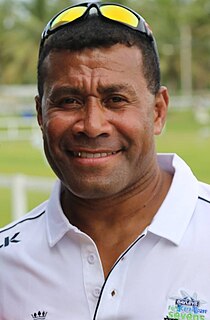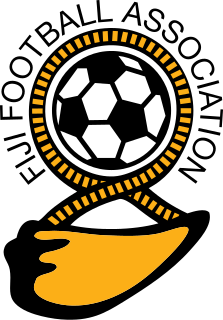
Fiji, officially the Republic of Fiji, is an island country in Melanesia, part of Oceania in the South Pacific Ocean about 1,100 nautical miles northeast of New Zealand. Fiji consists of an archipelago of more than 330 islands—of which about 110 are permanently inhabited—and more than 500 islets, amounting to a total land area of about 18,300 square kilometres (7,100 sq mi). The most outlying island is Ono-i-Lau. 87% of the total population of 883,483 live on the two major islands, Viti Levu and Vanua Levu. About three-quarters of Fijians live on Viti Levu's coasts, either in the capital city of Suva or in smaller urban centres such as Nadi—where tourism is the major local industry—or Lautoka, where the sugar-cane industry is paramount. Because of its terrain, the interior of Viti Levu is sparsely inhabited.

Suva is the capital and largest metropolitan city in Fiji. It is located on the southeast coast of the island of Viti Levu, in the Rewa Province, Central Division.

Fijian is an Austronesian language of the Malayo-Polynesian family spoken by some 350,000–450,000 ethnic Fijians as a native language. The 2013 Constitution established Fijian as an official language of Fiji, along with English and Fiji Hindi, and there is discussion about establishing it as the "national language". Fijian is a VOS language.

The national flag of Fiji was adopted on 10 October 1970. The state arms have been slightly modified but the flag has remained the same as during Fiji's colonial period. It is a defaced sky-blue "Blue Ensign", with the shield from the National Coat of Arms. It has remained unchanged since Fiji was declared a republic in 1987, despite calls from some politicians for changes.

The prime minister of the Republic of Fiji is the head of government of Fiji. The prime minister is appointed by the president under the terms of the 2013 Constitution of Fiji. He is the head of the cabinet and appoints and dismiss ministers.
Fiji Airways, is the flag carrier airline of Fiji and operates international services from its hubs in Fiji to 13 countries and 23 cities including Australia, New Zealand, Samoa, Tonga, Tuvalu, Kiribati, Vanuatu and Solomon Islands (Oceania), the United States, Hong Kong and Singapore. It has an extended network of 108 international destinations through its codeshare partners. The airline resumed direct flights to Japan (Tokyo–Narita) on 3 July 2018. The Fiji Airways Group brings in 64 percent of all visitors who fly to Fiji, employs over 1000 employees, and earns revenues of over FJD$815 million (US$390m).

Josaia Voreqe Bainimarama CF (MIL), OSt.J., MSD Fijian: [tʃoˈsɛia βoˈreŋɡe mbɛiniˈmarama] is the 8th and current prime minister of Fiji since 2007. He is commonly known as Frank Bainimarama and sometimes by the chief title Ratu. A member of the Fiji First Party, he began his career as a naval officer and commander of the Fijian Military Forces.
Fijians are a nation and ethnic group native to Fiji, who speak Fijian and share a common history and culture.

Waisale Tikoisolomoni Serevi is a Fijian former rugby union football player and coach, and is a member of the World Rugby Hall of Fame. Serevi is renowned for his achievements in rugby sevens, while also enjoying a long career in fifteen-a-side rugby at both club and national team levels. Nicknamed "The Wizard" by commentators, he is widely considered to be the greatest rugby sevens player in the history of the game. A biography of Serevi titled Waisale Serevi: King of Sevens by Nick Darvenzi was published in 2018.

The Fiji national football team is Fiji's national men's team and is controlled by the governing body of football in Fiji, the Fiji Football Association. The team plays most of their home games at the ANZ National Stadium in Suva.

The Fiji national rugby union team represents Fiji in men's international rugby union competes every four years at the Rugby World Cup, and their best performances were the 1987 and 2007 tournaments when they defeated Argentina and Wales respectively to reach the quarterfinals. Fiji also regularly plays test matches during the June and November test windows. Fiji also plays in the Pacific Tri-Nations, and has won the most Pacific Tri-Nations Championships of the three participating teams.

The Colony of Fiji was a British Crown colony that existed from 1874 to 1970 in the territory of the present-day nation of Fiji. London declined its first opportunity to annex the Kingdom of Fiji in 1852. Ratu Seru Epenisa Cakobau had offered to cede the islands, subject to being allowed to retain his Tui Viti title. His demand was unacceptable to both the British and to many of his fellow chiefs, who regarded him only as first among equals, if that. Mounting debts and threats from the United States Navy had led Cakobau to establish a constitutional monarchy with a government dominated by European settlers in 1871, following an agreement with the Australian Polynesia Company to pay his debts. The collapse of the new regime drove him to make another offer of cession in 1872, which the British accepted. On 10 October 1874, Britain began its rule of Fiji, which lasted until 10 October 1970.
The culture of Fiji is a tapestry of native Fijian, Indian, European, Chinese, and other nationalities. Culture polity traditions, language, food costume, belief system, architecture, arts, craft, music, dance, and sports will be discussed in this article to give you an indication of Fiji's indigenous community but also the various communities which make up Fiji as a modern culture and living. The indigenous culture is an active and living part of everyday life for the majority of the population.

The monarchy of Fiji arose in the mid-nineteenth century when native ruler Seru Epenisa Cakobau consolidated control of the Fijian Islands and declared himself King or paramount chief of Fiji. In 1874, he voluntarily ceded sovereignty of the islands to Britain, which made Fiji a Crown colony within the British Empire. After nearly a century of British rule, Fiji became a Dominion, an independent sovereign state within the Commonwealth of Nations with Elizabeth II as head of state. After a second military coup in 1987 led by Lieutenant Colonel Sitiveni Rabuka, Fiji became a republic, and the monarchy was ended. Nevertheless, the Great Council of Chiefs recognised Elizabeth II as Tui Viti or the traditional Queen of Fiji, but the position is not one of a constitutional, or otherwise legal nature. The Great Council of Chiefs was disestablished in 2012 by decree of President Ratu Epeli Nailatikau. Elizabeth II does not use the title, and the Fijian government does not recognise it.

The Fiji national cricket team is the team that represents the Republic of Fiji in international cricket. They have been an associate member of the International Cricket Council (ICC) since 1965, although the team's history goes back to the late 19th century.
Fiji Hindi or Fijian Hindi, also known locally as simply Hindustani, is an Indo-Aryan language spoken by most Fijian citizens of Indian descent, though a few speak other languages at home. It is an Eastern Hindi language, considered to be an older dialect of the Bhojpuri language spoken in northern-eastern India that has been subject to considerable influence by Awadhi and other Bihari languages. It has also borrowed some words from the English and Fijian languages. Many words unique to Fiji Hindi have been created to cater for the new environment that Indo-Fijians now live in. First-generation Indians in Fiji, who used the language as a lingua franca in Fiji, referred to it as Fiji Baat, "Fiji talk". It is closely related to Caribbean Hindustani and the Bhojpuri-Hindustani language spoken in Mauritius and South Africa. It is largely mutually intellegible with the languages of Bhojpuri, Magahi, etc of Bihar and the dialects of Hindi of eastern Uttar Pradesh, but differs in phonetics and vocabulary with Modern Standard Hindi.
Fiji has three official languages under the 1997 constitution : English, iTaukei and Hindi. The iTaukei language is spoken either as a first or second language by most indigenous Fijians who make up around 54% of the population.
Indo-Fijians or Indian Fijians, are Fiji citizens of fully or partially Indian descent, including descendants who trace their heritage from various regions of the Indian subcontinent. Although Indo-Fijians constituted a majority of Fiji's population from 1956 through the late 1980s, discrimination and the resulting brain drain resulted in them numbering 313,798 (37.6%) out of a total of 827,900 people living in Fiji as of 2007.

The COVID-19 pandemic in Fiji is part of the ongoing worldwide pandemic of coronavirus disease 2019 caused by severe acute respiratory syndrome coronavirus 2. The first case of the disease in Fiji was reported on 19 March 2020 in Lautoka. As of 29 December 2020, the country has had a total of 49 cases as of which 3 are currently active and 2 deaths, with all cases recorded in the islands of Viti Levu and Vanua Levu.
careFIJI is a mobile software application developed by the Government of Fiji to assist the Ministry of Health and Medical Services to combat the ongoing COVID-19 pandemic in Fiji. The mobile app is available on Google Play and App Store.










